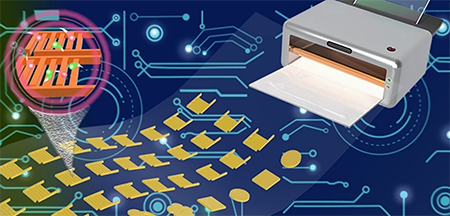| Jun 10, 2021 |
Printing flexible wearable electronics for smart device applications
(Nanowerk News) The demand for flexible wearable electronics has spiked with the dramatic growth of smart devices that can exchange data with other devices over the internet with embedded sensors, software, and other technologies. Researchers consequently have focused on exploring flexible energy storage devices, such as flexible supercapacitators (FSCs), that are lightweight and safe and easily integrate with other devices. FSCs have high power density and fast charge and discharge rates.
|
|
Printing electronics, manufacturing electronics devices and systems by using conventional printing techniques, has proved to be an economical, simple, and scalable strategy for fabricating FSCs. Traditional micromanufacturing techniques can be expensive and complex.
|
|
In Applied Physics Reviews ("Printed flexible supercapacitor: Ink formulation, printable electrode materials and applications"), by AIP Publishing, researchers from Wuhan University and Hunan University provide a review of printed FSCs in terms of their ability to formulate functional inks, design printable electrodes, and integrate functions with other electronic devices.
|
 |
| The printed flexible supercapacitor with customized patterns. (Image: Wei Wu's group)
|
|
Printed FSCs are generally manufactured by printing the functional inks on traditional organic and inorganic electrode materials on flexible substrates. Due to the thin film structure, these printed devices can be bent, stretched, and twisted to a certain radius without loss of electrochemical function.
|
|
In addition, the rigid current collector components of the supercapacitor can also be replaced by the flexible printed parts. Various printing techniques such as screen printing, inkjet printing, and 3D printing have been well established to fabricate the printed FSCs.
|
|
"The development of miniaturized, flexible, and planar high-performance electrochemical energy storage devices is an urgent requirement to promote the rapid development of portable electronic devices in daily life," said author Wu Wei. "We can imagine that in the future, we can use any printer in our lives and can print a supercapacitator to charge a mobile phone or smart wristband at any time."
|
|
The researchers found for printable ink formulations, two principles should be followed. First, when selecting ink components, it is vital to include fewer ineffective additives, better conductive binders, and excellent dispersion electrode materials. Second, the ink must have a suitable viscosity and a good rheology property to obtain excellent prints.
|
|
Printable functional materials, such as graphene and pseudocapacitive materials, are good core components of printed supercapacitators.
|
|
Since printed electronics offer the advantage of flexibility and low cost, they can be used to manufacture solar cells, flexible OLED displays, transistors, RFID tags, and other integrated smart devices. This opens up the possibility of many other applications, including smart textiles, intelligent packaging, and smart labels.
|

